




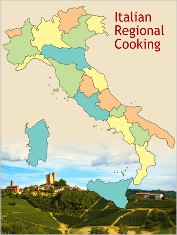


our Italian Cooking
Newsletter

DISCLAIMER and
PRIVACY POLICY
before using
our site
-
Advertise with us
site map
recipes
policies
about us




Extra-
The Best Selection of Italian Extra-
Buy from the source Authentic Aged Traditional Balsamic Vinegar from Italy
Sicily, Apulia, Lazio, Liguria, and More...The Best Selection of Succulent Italian Olives Oil
Infused Extra-
Spice up your dishes with Infused Flavored Italian Extra-
The legend of the invention of Risotto alla Milanese goes back to the year 1574. The Duomo di Milano, the magnificent Gothic cathedral, was being built, and a young apprentice named Valerius was in charge of staining the decorated glass for the windows. Everybody was teasing him because he appeared to have added saffron to the pigments to obtain a more brilliant color.
Tired of the teasing, he decided to return the joke and added saffron to the rice to be served at his master's wedding. The rice turned out so good that the idea spread immediately throughout the city and became the popular dish we know today.
Risotto Technique
The technique for making risotto probably came from trying to cook the rice as a puls (similar to porridge)—boiling it in milk, water, or broth until soft. In fact, a sort of rice porridge cooked in milk and sugar, rixo in bona manera (“rice in a good manner”), was documented in Venice since the fourteenth century.
Risotto is a very simple and nutritious dish, and easy to prepare. There are hundreds of types of risotto, varying by the flavoring ingredient used. Yet all risotto recipes call for four basic components: soffritto (sautéed vegetables), broth, flavoring ingredients, and Italian rice.
Soffritto is generally a combination of vegetables, butter, oil, and finely diced onions, sautéed in a large skillet where rice will be cooked. Sometimes a special recipe calls for different ingredients, however.
The broth, depending on the recipe, could be beef, chicken, vegetable, or fish. A good broth—homemade or canned—is the basis of a good risotto. To simplify the recipe, broth can be substituted with one or two bouillon cubes dissolved in warm water.
Flavoring ingredient is what will give the risotto dish its characteristic flavor. It is generally added to the soffritto, and it can be anything from vegetables (such as mushrooms, spinach, or endive), to ragu', seafood, meat, truffles, saffron, or wine, to name some examples.
Italian rice varieties all have large grains, are rich in starch, and have the capacity to absorb a considerable amount of cooking liquid while still remaining firm. Three basic types of rice are common in Italy:
Arborio rice is the best-
Vialone rice has a smaller grain and is very common in the Veneto area. It is generally cooked all’onda (wavy), that is, consistent but still soft and not too dry.
Carnaroli is first-
At the end butter and parmigiano cheese are usually added to risotto to complete the dish. The final result is a consistent paste with individual grains of rice still firm but stuck together due to the high starch content. Risotto is very satisfying and can be served as a first course or as a main course standing on its own.
Making a Perfect Risotto
Preparing a good risotto is very easy, but a few guidelines should be followed:
|
·
|
The rice must not be washed before cooking. Washing would eliminate a large part of the starch that gives the risotto its texture.
|
|
·
|
Choose the most appropriate variety of rice for the recipe you will prepare: Carnaroli for a consistent risotto, Vialone for a risotto all’onda, Arborio for all types of risotto.
|
|
·
|
Allow about 3–4 oz (75–100 g) of rice for each serving.
|
|
·
|
Use a large double-
|
|
·
|
Gently fry the butter and the extra-
|
|
·
|
Sauté the chopped onion on a low temperature until translucent for a maximum of 2 minutes, stirring constantly. Do not cook too long or the rice grains may harden. If this happens, they would no longer cook homogeneously and could loose their ability to absorb the condiments.
|
|
·
|
When the rice is toasted, dry white or red wine can be added if required by the recipe.
|
|
·
|
The secret to an excellent risotto is using a good homemade broth (see recipe at page 67). Keep the broth simmering the entire time.
|
|
·
|
At this point, turn the heat to medium and add half of the indicated amount of broth to the rice.
|
|
·
|
Keep the heat at medium until the rice is fully cooked. Spoon to prevent the risotto from sticking to the pan, and until the rice has absorbed all the broth.
|
|
·
|
When the rice is close to being fully cooked, taste it for readiness—finish when it is neither too hard nor too soft, but just al dente.
|
|
·
|
All types of Italian rice will cook al dente in about 18–20 minutes.
|
|
·
|
When the risotto is ready, remove the pan from the stove to avoid overcooking.
|
|
·
|
Stir the butter and the freshly grated parmigiano reggiano cheese into the risotto as required by the recipe.
|
|
·
|
Immediately pour the risotto into a warm serving dish and wait 2-
|
In May, every year before mechanization and until the 1960s, thousands of women left their homes in Emilia and Veneto to go to work in the rice fields.
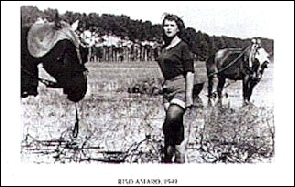
Many women worked for the first time far from home and family ties in a freedom never dreamed before. For eight hours, they worked barefoot in the water, protected from the sun by large straw hats. Dressed in short pants and long sleeves to protect their arms and legs from insects, they slowly walked backward, in a long row, bending toward the ground to pick up weeds that infested the rice fields. Famous are the melodies they sang—about their tough days, their resentment for their supervisors, and about love and their homes far away.
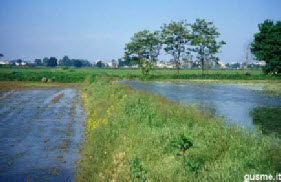
(photo by Stefano Gusmeroli) http://www.gusme.it/
Risotto Recipes
About Risotto History
and
How to make perfect Risotto
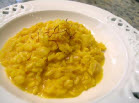
Risotto remains the most important staple dish for many people in all Northern Italy, and especially in Milan. Saffron is the key ingredient of this dish and gives the traditional flavor and color.
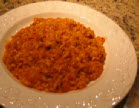
Risotto with Tomato Sauce is done adding meat-
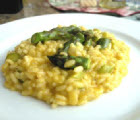
Risotto can be flavored with all kinds of ingredients. Asparagus is a perfect complement to risotto. The delicate taste of asparagus blends perfectly with the taste of parmigiano cheese.
Strawberry risotto is not sweet! Depending on the ripeness of the fruit, it will
have a wonderful fruity-
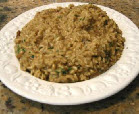
Risotto like pasta can be dressed with an endless variety of ingredients. Risotto with Dry Porcini Mushrooms is one of my favorites and for sure one of the tastiest way to enjoy rich and flavorful risotto.
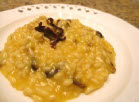
Risotto with Pumpkin and Red Radicchio. Colorful and savory, this risotto features the combination of sweet pumpkin (zucca gialla) and bitter red radicchio.
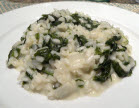
Spinach Risotto is truly a classic and one of my favorite. Easy to make, can be done in every season. I use Arborio rice for my risotto, but feel free to use Carnaroli rice for more texture or Vialone rice for a more “all’onda” creamy texture.